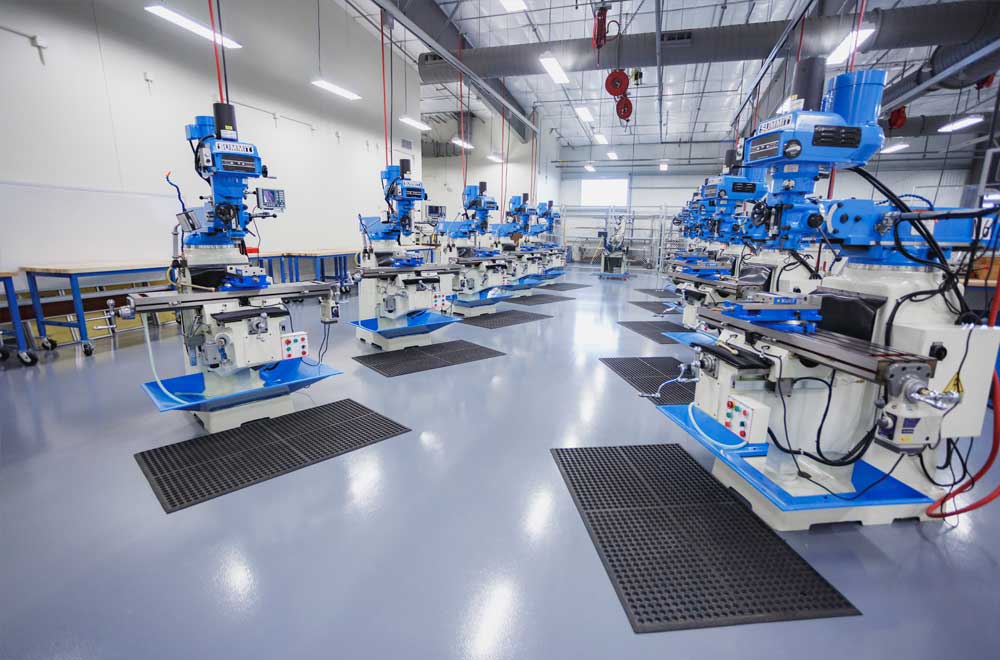Report on South Texas College’s Advanced Manufacturing Program and its Contribution to Sustainable Development Goals
Executive Summary
This report analyzes the impact of South Texas College’s (STC) Advanced Manufacturing Technology (AMT) program, using the case of student Hipolito Garcia, to illustrate its significant contributions to several United Nations Sustainable Development Goals (SDGs). The program serves as a model for providing quality education (SDG 4) that leads to decent work and economic growth (SDG 8), fosters industry innovation (SDG 9), and reduces inequalities (SDG 10) by empowering youth with in-demand skills.
Case Study: Hipolito Garcia
Hipolito Garcia, an 18-year-old graduate, exemplifies the program’s success. His journey highlights a direct pathway from educational challenges to professional achievement, aligning with key development objectives.
- Initial Hardship: Garcia overcame significant personal challenges, including dropping out of high school during the COVID-19 pandemic.
- Educational Re-engagement: He returned to high school and, through a dual-credit program with STC, earned a certificate in Precision Manufacturing Technology concurrently with his diploma.
- Economic Empowerment: Inspired by STC faculty, Garcia secured a full-time position at IHC Suspension immediately after graduation, achieving financial independence and the ability to support his family.
- Lifelong Learning: With support from his employer, Garcia is continuing his education at STC to pursue an Associate of Applied Science degree, demonstrating a commitment to continuous skill development.
Alignment with Sustainable Development Goals (SDGs)
The STC Advanced Manufacturing Program directly supports the achievement of multiple SDGs through its structure, curriculum, and outcomes.
- SDG 4: Quality Education
- The program provides inclusive, equitable, and accessible vocational training.
- It offers multiple pathways for lifelong learning, including Occupational Skills Awards, Certificates, and an Associate of Applied Science degree.
- Faculty provide personalized attention and mentorship, ensuring students are equipped to reach their full potential.
- SDG 8: Decent Work and Economic Growth
- The program boasts an immediate employment rate of over 87% for associate degree graduates, promoting full and productive employment.
- It establishes strong partnerships between academia and industry, such as the one with IHC Suspension, ensuring graduates possess relevant skills for decent work.
- By creating a skilled workforce, the program fuels local economic growth and resilience.
- SDG 9: Industry, Innovation, and Infrastructure
- The curriculum focuses on modern, advanced manufacturing technologies, including laser cutters, robotics, and mechatronics.
- It fosters innovation by preparing students to work in and contribute to sustainable industrialization.
- Graduates are equipped to support and enhance the technological infrastructure of the regional manufacturing sector.
- SDG 10: Reduced Inequalities
- The program provides opportunities for individuals from various backgrounds, including those who have faced educational setbacks, to achieve economic mobility.
- By connecting students directly with employers, STC actively works to reduce barriers to entry into skilled professions.
- Garcia’s success demonstrates how such programs empower youth, enabling them to overcome socioeconomic disadvantages.
Conclusion: A Model for Sustainable Development
The South Texas College Advanced Manufacturing Technology program is a powerful engine for sustainable development. By integrating quality education with industry needs, it not only facilitates individual success stories like that of Hipolito Garcia but also makes substantial contributions to achieving global goals for poverty reduction, economic prosperity, and innovation. The program’s emphasis on faculty mentorship, employer partnerships, and continuous learning provides a robust framework for building a skilled, resilient, and equitable workforce for the future.
Analysis of Sustainable Development Goals (SDGs) in the Article
1. Which SDGs are addressed or connected to the issues highlighted in the article?
The article highlights several issues that directly and indirectly connect to the following Sustainable Development Goals (SDGs):
- SDG 1: No Poverty – The story of Hipolito Garcia, who went from being a high school dropout to securing a well-paying job that allows him to support his retired parents, is a clear example of overcoming economic hardship and moving towards financial stability.
- SDG 4: Quality Education – The core of the article focuses on South Texas College (STC) and its role in providing technical and vocational education. It emphasizes how the college equipped a student with relevant skills for employment through certificates and degree programs.
- SDG 8: Decent Work and Economic Growth – The article centers on job creation, youth employment, and skill development leading to a productive career. Garcia’s journey from education to a full-time job in the manufacturing sector, along with the program’s high employment rate, directly addresses this goal.
- SDG 9: Industry, Innovation, and Infrastructure – The focus on the “Advanced Manufacturing Technology (AMT)” program, which involves modern industrial skills like using “laser cutters” and “tube benders,” connects to the goal of promoting inclusive industrialization and fostering innovation.
- SDG 10: Reduced Inequalities – The article shows how educational opportunities at STC are accessible to individuals who have faced challenges, such as being a high school dropout. By providing a pathway to success for a young person who had “struggled a lot,” the program helps reduce inequalities in opportunity.
2. What specific targets under those SDGs can be identified based on the article’s content?
Based on the article’s narrative and data, the following specific SDG targets can be identified:
- Target 4.4: “By 2030, substantially increase the number of youth and adults who have relevant skills, including technical and vocational skills, for employment, decent jobs and entrepreneurship.”
- Explanation: The article details how STC’s “Precision Manufacturing Technology” certificate and associate degree programs provide students like Garcia with the specific, relevant skills needed to secure employment in the manufacturing industry.
- Target 8.5: “By 2030, achieve full and productive employment and decent work for all women and men, including for young people…”
- Explanation: The story of Garcia, an 18-year-old securing a “full-time job” immediately after his training, and the mention of his “first raise” exemplify the achievement of productive employment and decent work for youth.
- Target 8.6: “By 2020, substantially reduce the proportion of youth not in employment, education or training (NEET).”
- Explanation: Although the target year has passed, the principle is central to the article. STC’s program directly addresses the issue by taking a former high school dropout and transitioning him into both higher education (working toward an associate degree) and full-time employment, thus reducing the NEET proportion.
- Target 1.2: “By 2030, reduce at least by half the proportion of men, women and children of all ages living in poverty in all its dimensions according to national definitions.”
- Explanation: Garcia’s success story implies a move out of economic vulnerability. He states, “I have a good job, and my parents are retired and living with me at a house I rent,” which demonstrates how targeted education and employment can serve as a direct pathway out of poverty.
3. Are there any indicators mentioned or implied in the article that can be used to measure progress towards the identified targets?
Yes, the article contains both direct and implied indicators for measuring progress:
- Indicator for Target 4.4: The number of students completing vocational programs.
- Evidence: The article mentions Garcia attaining a “certificate in Precision Manufacturing Technology” and working towards an “associate degree.” The number of students receiving these qualifications is a direct measure of skill acquisition.
- Indicator for Target 8.5/8.6: The employment rate of program graduates.
- Evidence: The article explicitly states a key performance indicator for the program: “more than 87% of AMT students who receive an associate degree get hired immediately.” This is a direct quantitative indicator of the program’s success in securing employment for youth.
- Indicator for Target 1.2: Increase in income and economic self-sufficiency.
- Evidence: Progress is implied through Garcia’s statement, “I just received my first raise.” This indicates an increase in disposable income. His ability to rent a house and support his parents also serves as a qualitative indicator of moving away from poverty.
- Indicator for Target 9.2: Job creation in the manufacturing sector.
- Evidence: The article mentions Garcia securing a “full-time job with Palmview-based suspension company, IHC Suspension.” This serves as an example of employment being generated within the industrial sector as a result of skilled labor becoming available.
4. Summary of Findings
| SDGs | Targets | Indicators |
|---|---|---|
| SDG 4: Quality Education | Target 4.4: Increase the number of youth and adults with relevant technical and vocational skills for employment. | The number of students attaining a “certificate in Precision Manufacturing Technology” and enrolling in the “Associate of Applied Science” program. |
| SDG 8: Decent Work and Economic Growth | Target 8.5: Achieve full and productive employment and decent work for young people. Target 8.6: Reduce the proportion of youth not in employment, education or training (NEET). |
The high employment rate of graduates (“more than 87% of AMT students… get hired immediately”). Garcia securing a “full-time job” and receiving his “first raise.” |
| SDG 1: No Poverty | Target 1.2: Reduce the proportion of people living in poverty. | Qualitative evidence of economic improvement: A young person is able to “rent a house” and support his “retired parents.” |
| SDG 9: Industry, Innovation, and Infrastructure | Target 9.2: Promote inclusive and sustainable industrialization and raise industry’s share of employment. | The creation of skilled jobs in the “Advanced Manufacturing Technology” sector, such as at “IHC Suspension.” |
| SDG 10: Reduced Inequalities | Target 10.2: Empower and promote the social and economic inclusion of all, irrespective of age or other status. | The program’s success in providing opportunities for a “high school dropout” who had “struggled a lot,” enabling his economic inclusion. |
Source: texasborderbusiness.com







